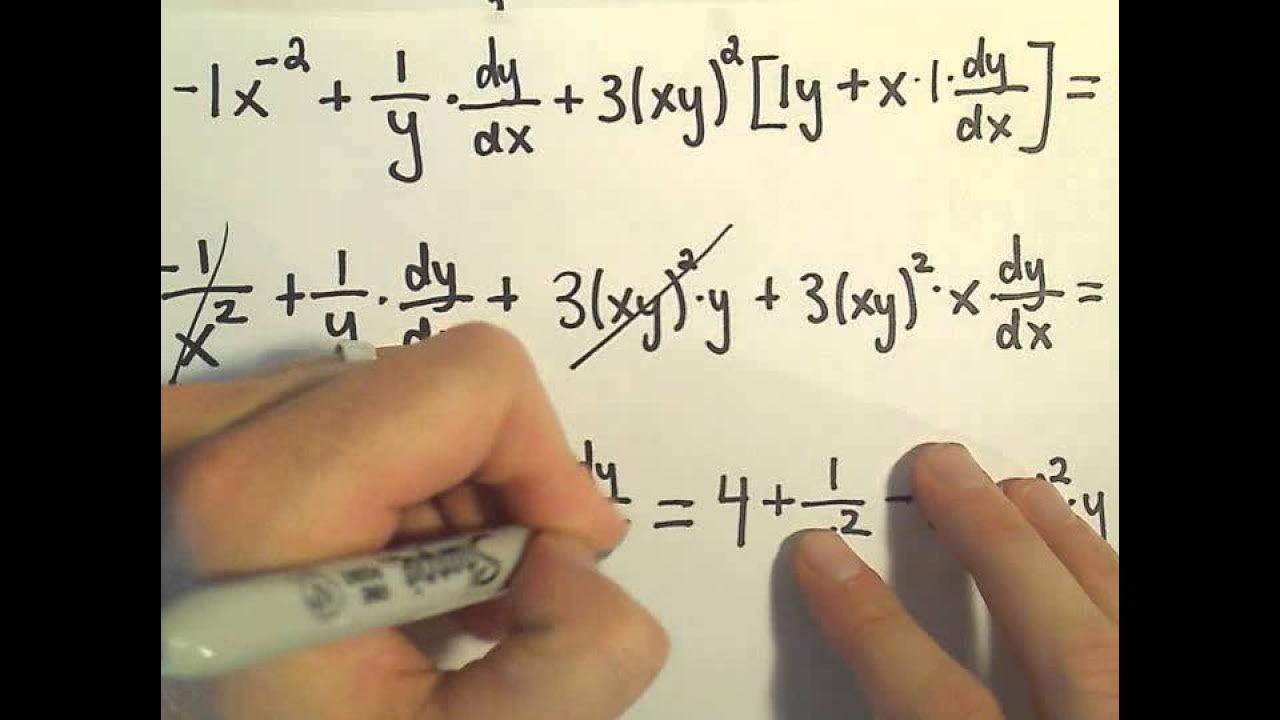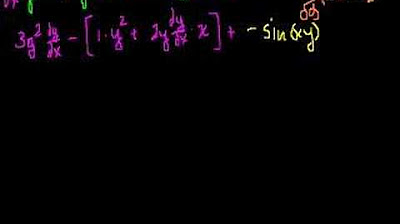Worked example: Implicit differentiation | Advanced derivatives | AP Calculus AB | Khan Academy
TLDRThe video script presents a step-by-step guide on performing implicit differentiation, a crucial technique in calculus. It begins by setting up the problem, assuming y is a function of x, and then applies the derivative operator to an equation involving x and y. The chain rule is used to find the derivative of the left side of the equation, while the right side involves the derivative of x and a constant. The process involves simplifying and rearranging terms to solve for the derivative of y with respect to x, resulting in a final expression that gives the derivative in terms of y and x.
Takeaways
- 📚 The topic is implicit differentiation, focusing on finding the derivative of y with respect to x when y is a function of x.
- 🔍 The derivative operator is applied to both sides of the given equation, emphasizing the use of the chain rule for the left-hand side.
- 📈 The chain rule is applied to the term (x - y^2), resulting in 2x - 2y^1 times the derivative of x - y with respect to x.
- 🌟 The derivative of x with respect to x is 1, while the derivative of y with respect to x is the unknown we are solving for, denoted as dy/dx.
- 🤔 The right-hand side of the equation simplifies to 1 (derivative of x) plus the derivative of y with respect to x (dy/dx), and 0 (derivative of a constant).
- 🧩 The process involves solving for dy/dx by isolating it on one side of the equation through algebraic manipulation.
- 📊 By rewriting and distributing terms, we aim to get all dy/dx terms on one side and the non-dy/dx terms on the other.
- 🎯 After simplification, the equation becomes (2y - 2x - 1) times dy/dx equals 1 - 2x + 2y.
- 📝 To solve for dy/dx, we divide both sides of the equation by (2y - 2x - 1), yielding the final expression for the derivative of y with respect to x.
- 🌐 The key to solving this problem is understanding the chain rule and carefully performing algebraic operations to isolate dy/dx.
- 🎓 The final result is the derivative of y with respect to x, expressed as (2y - 2x + 1) / (2y - 2x - 1).
Q & A
What is the main topic of the script?
-The main topic of the script is implicit differentiation, specifically finding the derivative of y with respect to x given an equation.
What is the initial assumption made in the script?
-The initial assumption made in the script is that y is a function of x.
What mathematical rule is first applied to the left-hand side of the equation?
-The chain rule is first applied to the left-hand side of the equation.
What does the chain rule give us in this context?
-In this context, the chain rule gives us the derivative of (x - y^2) with respect to x, which is 1 - (dy/dx).
What is the derivative of a constant with respect to x?
-The derivative of a constant with respect to x is 0.
How does the script simplify the expression 2x - 2y?
-The script simplifies the expression 2x - 2y by distributing the 2 across x and y, resulting in 2x - 2y = 2(x - y).
What is the final expression for the derivative of y with respect to x, dy/dx?
-The final expression for the derivative of y with respect to x, dy/dx, is (2y - 2x + 1) / (2y - 2x - 1).
What is the key step in solving for dy/dx?
-The key step in solving for dy/dx is rearranging the terms to isolate dy/dx on one side of the equation and then dividing both sides by the expression (2y - 2x - 1).
How does the script demonstrate the process of implicit differentiation?
-The script demonstrates the process of implicit differentiation by applying the derivative operator to both sides of an equation, using the chain rule, simplifying the expression, and then solving for the unknown derivative.
What is the significance of the final expression for dy/dx obtained in the script?
-The significance of the final expression for dy/dx is that it represents the derivative of y with respect to x, which is the main objective of the exercise and can be used for further analysis or in other mathematical contexts.
What algebraic technique is used to isolate dy/dx?
-The algebraic technique used to isolate dy/dx is subtracting 2x - 2y and dy/dx from both sides of the equation to separate the terms involving dy/dx from those that do not.
Outlines
📚 Implicit Differentiation Practice
This paragraph introduces the concept of implicit differentiation, emphasizing the need for more practice to master the technique. The speaker guides the audience through the process of finding the derivative of 'y' with respect to 'x', assuming 'y' is a function of 'x'. The explanation includes applying the derivative operator to both sides of an equation, utilizing the chain rule on the left-hand side, and simplifying the expression to isolate the derivative of 'y' with respect to 'x'. The paragraph concludes with the derived formula for the derivative, expressed as (2y - 2x + 1) / (2y - 2x - 1), highlighting the algebraic process required to solve for 'dy/dx'.
Mindmap
Keywords
💡Implicit Differentiation
💡Derivative Operator
💡Chain Rule
💡Rate of Change
💡Algebra
💡Constant
💡Solving Equations
💡Derivative of x with respect to x
💡Differential Equation
💡Slope
💡Rate of Change Interpretation
Highlights
The process of implicit differentiation is introduced, which is a key concept in calculus.
The assumption that y is a function of x is fundamental to the problem-solving approach.
The application of the derivative operator to both sides of the equation is a critical step in the process.
The use of the chain rule is highlighted as essential in differentiating the left-hand side of the equation.
The derivative of x with respect to x is identified as 1, a basic calculus fact.
The goal of solving for the derivative of y with respect to x (dy/dx) is clearly stated.
The algebraic manipulation of terms, including the distribution of 2, is a key part of the process.
The simplification of the equation by combining like terms is demonstrated.
The strategy of isolating dy/dx on one side of the equation is explained.
The subtraction of non-dy/dx terms from both sides to simplify the equation is a highlighted technique.
The final form of the derivative of y with respect to x is derived and presented.
The importance of the algebraic steps in solving for dy/dx is emphasized.
The solution is expressed in a simplified fraction, showcasing the final result of the differentiation process.
The method of solving for dy/dx is applicable to a wide range of mathematical problems.
The transcript serves as a comprehensive guide for those learning implicit differentiation.
The clear and step-by-step explanation ensures the process is accessible to a broad audience.
The practical application of the chain rule in implicit differentiation is demonstrated.
The transcript provides a solid foundation for further exploration of calculus concepts.
Transcripts
Browse More Related Video

Second derivatives (implicit equations): find expression | AP Calculus AB | Khan Academy

How to use implicit differentiation on an equation for dy dx

Implicit Differentiation for Calculus - More Examples #2

Implicit Differentiation for Calculus - More Examples, #1

Implicit Differentiation - More Examples

Implicit Differentiation (part 2)
5.0 / 5 (0 votes)
Thanks for rating: